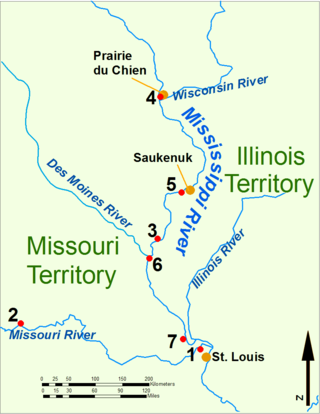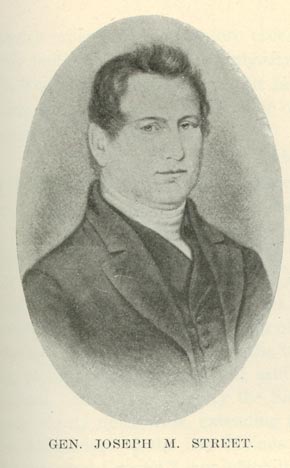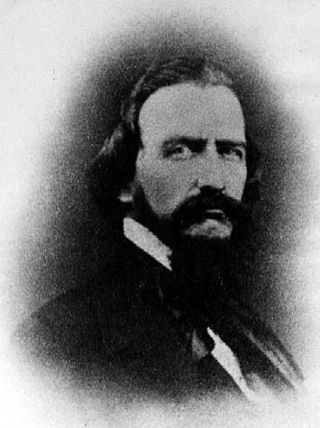
The Black Hawk War was a conflict between the United States and Native Americans led by Black Hawk, a Sauk leader. The war erupted after Black Hawk and a group of Sauks, Meskwakis (Fox), and Kickapoos, known as the "British Band", crossed the Mississippi River, to the U.S. state of Illinois, from Iowa Indian Territory in April 1832. Black Hawk's motives were ambiguous, but he was apparently hoping to reclaim land that was taken over by the United States in the disputed 1804 Treaty of St. Louis.

Scouting in Iowa has a long history, from the 1910s to the present day, serving thousands of youth in programs that suit the environment in which they live.

Prairie du Chien is a city in and the county seat of Crawford County, Wisconsin, United States. The population was 5,506 at the 2020 census. Its ZIP code is 53821.
Fort Johnson was a U.S. Army post built on bluffs overlooking the Mississippi River in modern-day Warsaw, Illinois, during the War of 1812. The fort was established in September 1814 by Major Zachary Taylor, future 12th President of the United States (1849–1850). Troops retreating from the Battle of Credit Island constructed the fort after effectively surrendering control of the upper Mississippi to the British and allied Indian tribes, including the Sauk. The fort, which held a full company of men, was completed in just a few weeks, and had a commanding view of the Mississippi valley, the mouth of the Des Moines River, and the foot of the Des Moines Rapids. Because of the chaotic situation along the Mississippi River frontier, the fort was abandoned in late October 1814 after provisions ran out. The company retreated to Cap au Gris near St. Louis.

Fort Crawford was an outpost of the United States Army located in Prairie du Chien, Wisconsin, during the 19th century.

The Rock Island Arsenal comprises 946 acres and is located on Arsenal Island, originally known as Rock Island, on the Mississippi River between the cities of Davenport, Iowa, and Rock Island, Illinois. It is home to the United States Army First Army Headquarters, and the United States Army Center of Excellence for Additive Manufacturing.

Black Hawk, born Ma-ka-tai-me-she-kia-kiak, was a Sauk leader and warrior who lived in what is now the Midwestern United States. Although he had inherited an important historic sacred bundle from his father, he was not a hereditary civil chief. Black Hawk earned his status as a war chief or captain by his actions: leading raiding and war parties as a young man and then a band of Sauk warriors during the Black Hawk War of 1832.

The Black Hawk Purchase, also known as the Forty-Mile Strip or Scott's Purchase, extended along the West side of the Mississippi River from the north boundary of Missouri North to the Upper Iowa River in the northeast corner of Iowa. It was fifty miles wide at the ends, and forty in the middle, and is sometimes called the "Forty-Mile Strip". The land, originally owned by the Sauk, Meskwaki (Fox), and Ho-Chunk (Winnebago) Native American people, was acquired by treaty following their defeat by the United States in the Black Hawk War. After being defeated the Sauk and Mesquakie were forced to relinquish another 2.5 million hectares or and give up their rights to plant, hunt, or fish on the land. The purchase was made for $640,000 on September 21, 1832 and was named for the chief Black Hawk, who was held prisoner at the time the purchase was completed. The Black Hawk Purchase contained an area of 6 million acres (24,000 km²), and the price was equivalent to 11 cents/acre. The region is bounded on the East by the Mississippi River and includes Dubuque, Fort Madison, and present-day Davenport.

The Bad Axe Massacre was a massacre of Sauk (Sac) and Fox Indians by United States Army regulars and militia that occurred on August 1–2, 1832. This final scene of the Black Hawk War took place near present-day Victory, Wisconsin, in the United States. It marked the end of the war between white settlers and militia in Illinois and Michigan Territory, and the Sauk and Fox tribes under warrior Black Hawk.

Fort Armstrong (1816–1836), was one of a chain of western frontier defenses which the United States erected after the War of 1812. It was located at the foot of Rock Island, in the Mississippi River near the present-day Quad Cities of Illinois and Iowa. It was five miles from the principal Sauk and Meskwaki village on the Rock River in Illinois. Of stone and timber construction, 300 feet square, the fort was begun in May 1816 and completed the following year and consisted of three large blockhouses, like the replica, on its prominent corners. In 1832, the U.S. Army used the fort as a military headquarters during the Black Hawk War. It was normally garrisoned by two companies of United States Army regulars. With the pacification of the Indian threat in Illinois, the U.S. Government ceased operations at Fort Armstrong and the U.S. Army abandoned the frontier fort in 1836.

The Siege of Prairie du Chien was a British victory in the far western theater of the War of 1812. During the war, Prairie du Chien was a small frontier settlement with residents loyal to both American and British causes. By 1814, both nations were anxious to control the site because of its importance to the fur trade and its strategic location at the intersection of the Mississippi River and the Fox-Wisconsin Waterway, a transportation route linking the Mississippi with the Great Lakes.

Warrior was a privately owned and constructed steamboat that was pressed into service by the U.S. government during the Black Hawk War to assist with military operations. Warrior was constructed and launched in 1832 at Pittsburgh, Pennsylvania by Joseph Throckmorton who also served as the vessel's captain. Once constructed the vessel traveled to St. Louis and into the war zone. Warrior played a key role in the decisive Battle of Bad Axe. Following the war the steamboat continued its service under Throckmorton along the Upper Mississippi River.
Davenport, Iowa, was part of the Louisiana Purchase. In 1814, during the War of 1812 the British military, along with the Saux and Fox Indian tribes fought against the Americans near Davenport. In August, Major Zachary Taylor, later President, fought a battle east of what is now Credit Island Park, in Davenport. An outpost was set up at Fort Armstrong and George Davenport and Antoine LeClaire were stationed there.

General Joseph Montfort Street was a 19th-century American pioneer, trader and US Army officer. During the 1820s and 1830s, he was also a U.S. Indian Agent to the Winnebago and later to the Sauk and Fox tribes after the Black Hawk War. His eldest son was Joseph H. D. Street, the first appointed registrar of the Council Bluffs Land Office in western Iowa.

Nicholas Boilvin (1761–1827) was a 19th-century American frontiersman, fur trader, and U.S. Indian Agent. He was the first appointed agent to the Winnebagos, as well as the Sauk and Fox, and one of the earliest pioneers to settle in present-day Prairie du Chien, Wisconsin. His sons Nicholas Boilvin, Jr. and William C. Boilvin both became successful businessmen in Wisconsin during the mid- to late 19th century.

Wabasha II, also known as Wapahasha, Wapasha, or "The Leaf," succeeded his father as head chief of the Mdewakanton Dakota tribe in the early 1800s. He led the Dakota forces fighting with the British in the War of 1812, but sided with the United States in the Black Hawk War of 1832. Chief Wabasha II signed the Treaties of Prairie du Chien in 1825 and 1830.

Quashquame was a Sauk chief; he was the principal signer of the 1804 treaty that ceded Sauk land to the United States government. He maintained two large villages of Sauk and Meskwaki in the early 19th century near the modern towns of Nauvoo, Illinois and Montrose, Iowa, and a village or camp in Cooper County, Missouri.
William Abbe (1800–1854) was an Iowa state senator and is believed to have been the first white settler in Linn County, Iowa. Originally from Ohio, he traveled west in search of land in 1836. Little is known about Abbe until this time. Abbe Creek, on which he established his homestead, still bears his name today. A one-room school house was established on the homestead site in 1856 and still stands today bearing the name of Abbe Creek School. He died in 1854 in California and was buried in Sacramento.

The Battle of Rock Island Rapids, also called the Battle of Campbell Island, was an American defeat during the War of 1812 at the hands of the British allied Sauk, Fox, and Kickapoo. In July 1814, a military expedition was mounted to supply the U.S. garrison at Prairie du Chien after calls for help. The U.S. expedition was ambushed on July 19. In the aftermath another expedition was sent to re-capture Prairie after it fell to the British. This expedition was also ambushed in the Battle of Credit Island and forced to retreat southwards.

The Treaty of St. Louis of 1804 was a treaty concluded by William Henry Harrison on behalf of the United States of America and five Sauk and Meskwaki chiefs led by Quashquame.





















